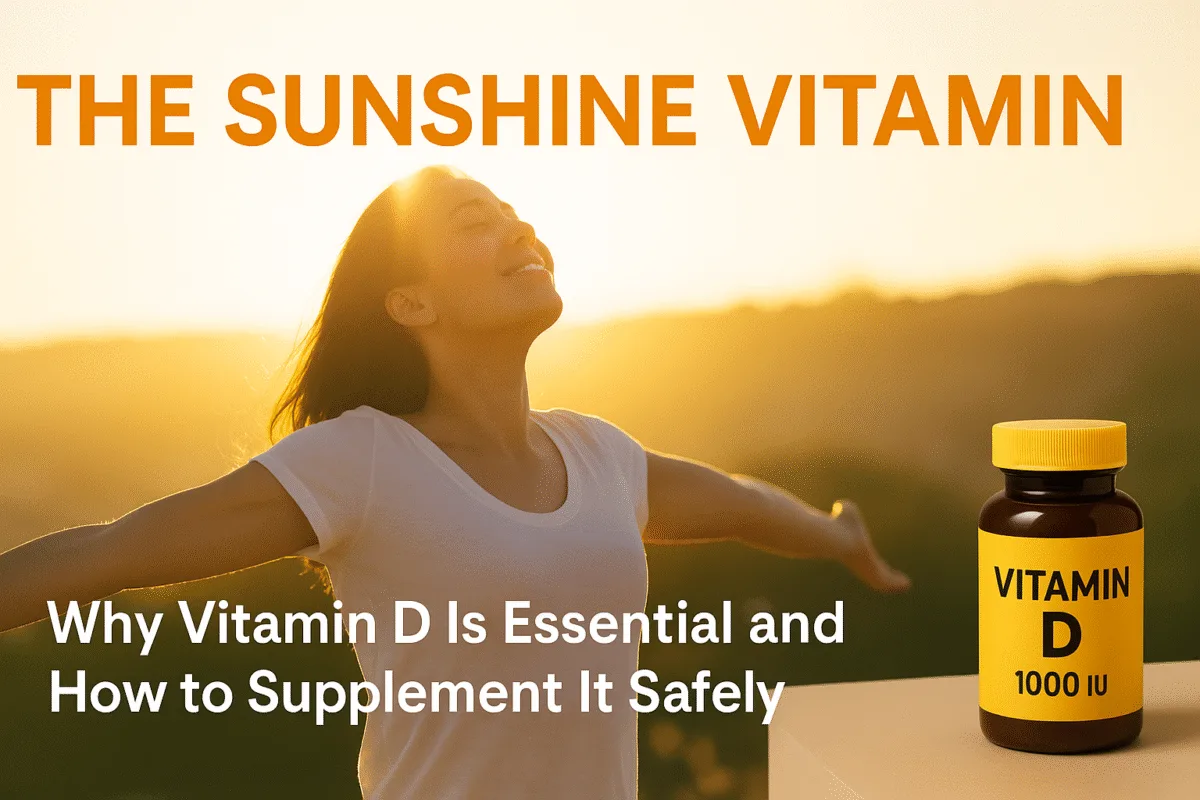Introduction: Vitamin D Is a Health Hero Hiding in Plain Sight
Often overshadowed by more popular nutrients like Vitamin C or protein, Vitamin D plays a far more foundational role in human health than most people realize. Dubbed the “sunshine vitamin” because the skin produces it in response to ultraviolet B (UVB) sunlight, Vitamin D acts as a prohormone — influencing over 2,000 genes and regulating calcium, phosphate, and immune function.
Yet, despite its biological importance, Vitamin D deficiency is one of the most common yet overlooked health issues globally — especially in modern, indoor-centric lifestyles.
This article will explain why Vitamin D is essential, how to recognize deficiency symptoms, how to test and supplement safely, and ways to optimize your natural and dietary intake.
☀️ What Exactly Is Vitamin D?
Vitamin D isn’t just a simple vitamin — it’s a fat-soluble secosteroid hormone precursor. Once it’s synthesized in the skin or ingested through diet, it undergoes a two-step activation process:
- Liver: Converts it to 25-hydroxyvitamin D [25(OH)D], the storage form.
- Kidneys: Convert 25(OH)D into calcitriol, the active hormone.
There are two main forms:
- D2 (ergocalciferol): Found in some plants and fortified foods.
- D3 (cholecalciferol): Produced by skin in response to sunlight; more bioavailable and longer-lasting in the body.
🦴 Health Benefits of Vitamin D (Backed by Science)
1. Bone Health & Calcium Regulation
Vitamin D regulates calcium and phosphorus absorption, vital for developing and maintaining healthy bones. Without sufficient Vitamin D, calcium absorption drops, leading to soft bones (rickets in children, osteomalacia in adults) or osteoporosis.
2. Immune Support
Vitamin D modulates innate and adaptive immunity. It promotes pathogen-fighting molecules and dampens excessive inflammation, making it vital in fighting infections. Studies link low Vitamin D to respiratory infections, autoimmune conditions, and even poor outcomes in COVID-19.
3. Mood, Brain, and Mental Health
Vitamin D influences serotonin production, a key neurotransmitter for mood regulation. Multiple studies suggest links between low Vitamin D levels and depression, SAD (Seasonal Affective Disorder), cognitive decline, and anxiety.
4. Cardiovascular Health
Some studies suggest Vitamin D may reduce blood pressure, improve endothelial function, and lower risk of heart disease by influencing calcium deposition in blood vessels.
5. Muscle Function and Fall Prevention
Vitamin D enhances muscle contraction and nerve signaling. Deficiency increases risk of muscle weakness, pain, and falls in older adults.
⚠️ Vitamin D Deficiency: Signs, Symptoms, and Risk Factors
🚨 Common Symptoms of Low Vitamin D:
- Fatigue and low energy
- Bone pain and joint aches
- Frequent infections or illness
- Depression or mood swings
- Hair thinning or loss
- Slow wound healing
- Muscle weakness or cramps
👥 At-Risk Populations:
- People with dark skin tones (melanin blocks UVB absorption)
- Those living in high latitudes or low sunlight areas
- Office workers or homebound individuals
- Elderly individuals
- Overweight/obese individuals (Vitamin D is sequestered in fat)
- People with gut absorption issues (e.g., Crohn’s, celiac)
📊 Optimal Levels: What Does the Science Say?
🧪 How to Test:
Ask your doctor for a 25(OH)D blood test. This is the best indicator of your Vitamin D status.
✅ Blood Levels Guide:
| Vitamin D Level (25(OH)D) | Interpretation |
|---|---|
| < 20 ng/mL | Deficient |
| 20–29 ng/mL | Insufficient |
| 30–50 ng/mL | Adequate (bare minimum) |
| 50–70 ng/mL | Optimal for health |
| 70–100 ng/mL | Therapeutic for disease |
| > 100 ng/mL | Potentially toxic |
Ideal range: 50–70 ng/mL for most people.
💊 Safe Supplementation: What You Need to Know
🟢 1. Choose the Right Type: D3 Over D2
Vitamin D3 (cholecalciferol) is superior to D2 in maintaining serum levels. Choose D3 supplements — ideally combined with K2 to prevent calcium buildup in arteries.
🟢 2. Combine with Healthy Fats
As a fat-soluble vitamin, D3 is best taken with meals that contain fat for optimal absorption (e.g., nuts, eggs, olive oil).
🟢 3. Dose Wisely
| Situation | Suggested Daily Dose |
|---|---|
| Maintenance dose | 1,000–2,000 IU |
| Mild deficiency | 2,000–4,000 IU |
| Severe deficiency | 5,000+ IU (with doctor supervision) |
Upper safe limit (UL): 4,000 IU/day for healthy adults unless prescribed.
Caution: Long-term overdosing can lead to hypercalcemia, kidney stones, and calcification of arteries.
🟢 4. Add K2 and Magnesium
- Vitamin K2 (MK-7) helps direct calcium into bones instead of arteries.
- Magnesium is needed to convert Vitamin D to its active form.
🥗 Natural Sources of Vitamin D
Though food alone is usually insufficient, here are good dietary sources:
| Food Source | IU per Serving |
|---|---|
| Cod liver oil (1 tsp) | 400–1,000 IU |
| Salmon (3 oz) | 400–600 IU |
| Sardines (3.5 oz) | 270 IU |
| Egg yolk (1 large) | 40 IU |
| Fortified milk (1 cup) | 100 IU |
| Mushrooms (UV-exposed) | 150–450 IU |
🌞 Sunlight: The Natural Way to Synthesize Vitamin D
The skin can make up to 10,000–20,000 IU of Vitamin D after 20–30 minutes of full-body sun exposure (without sunscreen). However, this depends on:
- Time of day: Midday sun (10 am–2 pm) is ideal
- Geographic location: Farther from the equator = less UVB
- Skin tone: Darker skin requires more exposure
- Season: Winter months = almost no Vitamin D production
Tip: Just 10–20 minutes of midday sun on arms and legs a few times per week can significantly boost levels (for fair skin).
⚠️ Vitamin D Toxicity: Is It a Real Concern?
While toxicity is rare, chronic high-dose supplementation (10,000+ IU/day for months) can lead to:
- Nausea
- Vomiting
- Dehydration
- Hypercalcemia (high calcium in blood)
- Kidney dysfunction
Stick to < 4,000 IU/day unless medically advised otherwise, and monitor your levels.
✅ Key Takeaways for Healthy Supplementation
| Step | Why It Matters |
|---|---|
| Test blood levels | Know your baseline & track progress |
| Use D3 + K2 | Most bioavailable and prevents calcification |
| Pair with fat & magnesium | Enhances absorption and conversion |
| Supplement daily | Consistency > megadoses |
| Get moderate sun exposure | Free, natural Vitamin D |
🧠 Final Thoughts: Shine From the Inside Out
Vitamin D is not just a bone vitamin — it’s a master regulator of everything from your immune defense and mood to your heart and brain. With lifestyle changes, smarter supplementation, and awareness, you can maintain optimal levels year-round.
Let your health shine — from the inside out — with the right dose of sunshine and science.

